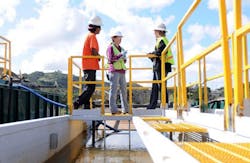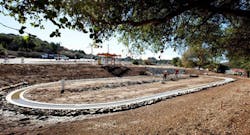Stormwater solutions spearhead restoration of rocket testing facility
At Santa Susana, a former rocket engine testing facility in southern California, Boeing is using sophisticated engineered stormwater treatment systems to ensure that rainwater leaving the site exceeds standards for drinking water.
A multitude of state-of-the-art stormwater treatment systems have been installed at the former Santa Susana Field Laboratory (SSFL) in the Simi Hills of California. The former rocket and energy test site near Chatsworth, 30 miles from downtown Los Angeles, faces some of the most stringent National Pollutant Discharge Elimination System (NPDES) limits for stormwater runoff in the nation as regulators seek to clean waterways flowing to Mugu Lagoon in Ventura County and the Los Angeles River.
No easy task, the 2,850-acre SSFL site resembles a rumpled blanket of mountainous watersheds, pocked by chemical residue and low-level radioactive contamination from America's leading rocket engine test center. But cleanup is underway to transition the site from a premier Cold-War-era research and testing site to an open-space parkland atop spectacular mountain terrain amidst a megalopolis.
The Boeing Company is making solid progress: The site meets stringent discharge limits established under the Clean Water Act 94 to 100 percent of the time, contingent on storm events.
"The runoff from the SSFL site is, in most cases, better than what you'd find in the city or a residential neighborhood," said Boeing Environmental Operations and Compliance Manager Paul Costa. "We're required to monitor stormwater more often than municipalities or other industries, and when we do, we are required to meet limits that are typically at or below drinking water standards."
Ironically, in most cases, runoff from SSFL gets dirtier once it comingles with urban runoff downstream.
In 2008, to address the challenge of cleaning up runoff from the SSFL site, Boeing hired an independent panel of five internationally recognized surface water experts from UCLA, the University of Alabama, Humboldt State University, and other institutions to study the site, conduct public meetings and identify remedies. Operating with broad autonomy, the panel prescribed a fusion of active treatments, best management practices and passive measures, ranked them by importance, and even helped design them.
Guided by the panel, Boeing implemented more than a dozen specific measures, including new sampling stations, biofiltration units incorporating native plants, pavement removal, erosion controls, culvert modifications, sediment basins, channel modifications, and rock riprap in creeks.
Of the 74,000 cubic yards of contaminated soil recently removed from the site, 20 percent of it was a direct result of recommendations by the panel. The company also built two large surface water treatment plants for $25 million. The largest one can treat 1,000 gallons per minute of runoff -- the equivalent of three swimming pools per hour, an enormous investment for a part-time treatment system engineered to handle brief but intense downpours a few weeks per year.
Over the past nine years, Boeing has spent more than $11,000 per acre to comply with NPDES limits. With so much progress, now one of the biggest compliance challenges at SSFL is not contaminants from rocket tests or energy research but dioxins from legacy activities as well as naturally occurring sources such as ash from area wildfires.
To assist in addressing this challenge, Boeing recently unveiled a new $600,000 "biofilter" that uses natural settling, plant uptake, soil processes, and specially designed filter media to capture sediment and pollutants before releasing cleaner water back into the watershed.
"Our new biofiltration system supports Boeing's overall strategy to use natural processes to treat stormwater and is one component of the company's comprehensive surface water treatment programs," Costa said.
Boeing partnered with the LA Conservation Corps to grow native plants and collaborated with the Pollinator Partnership to ensure the landscape would support diverse pollinators. The result is a biofilter that acts like a natural ecosystem.
Stormwater runoff from a 4.5-acre parking lot is collected in a trench drain that flows into a buried concrete storage tank, which is located under the parking lot. Large debris and sand are trapped in the tank while the stormwater is pumped to a sedimentation basin where smaller silt particles settle. The stormwater then flows to a filter bed where plants, soil and a specially designed filter media removes pollutants using natural physical, chemical and biological processes.
Water exits from the bottom of the biofilter into an outlet pipe (like a French drain) that discharges cleaner water to the nearby drainage. Native vegetation planted above the biofilter helps prevent stormwater pollution, provides surface erosion control and soil aeration, and promotes pollinator habitat.
More work remains, especially in the 536-acre watershed at the north end of the site, and the expert panel presses on with recommended improvements each year. Yet today, SSFL serves as a model for local governments -- such as the city of Los Angeles and Los Angeles County facing stringent discharge limits -- that visit the site to learn how to solve stormwater challenges in a complex ecological, technological and political matrix.
Other cleanup activities at Santa Susana include analyzing 50,000 soil bedrock and groundwater samples; installing 400 monitoring and extraction wells on and offsite; removing 400 buildings, tanks, test stands, and structures; installing an advanced groundwater treatment system; replanting 900 acres of land with native vegetation; and reseeding the area with native plants and grasses.
Since acquiring its portion of the site in 1996, Boeing has made significant progress toward cleanup and restoration and is moving toward the company's goal of preserving the site as open space parkland. For more information on the project, visit www.boeing.com/santasusana.com.



